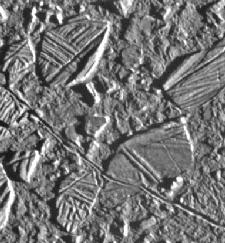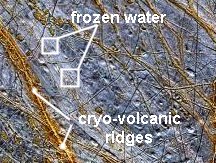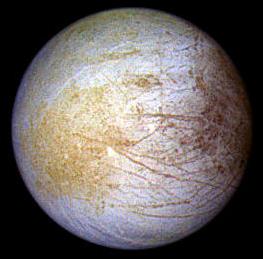Europa: Life's Best Bet in the Solar System
You've probably never even heard of Europa.. Unless you happen to have seen(read) Arthur C. Clarke's 2001, 2010, 2061 and 3001. He's got a real fascination with Europa! How much of it is fact over fiction? More than you might think!
Europa is similar in bulk composition to the terrestrial planets: primarily composed of silicate rock. Europa's density (3 g/cc) indicates it has a significant, perhaps 15 % or more, fraction of ice. This ice has already been seen as a thin outer layer on Europa's surface, and it is exceedingly smooth. There is a disturbing lack of valleys, mountains, and even impact craters, seen on Europa. Only 3 craters > 5 km have been found, indicating a very young and active surface (which can re-surface itself frequently).
 Europa's surface close up
Europa's surface close up
This high resolution image shows the ice-rich crust of Europa.
It shows crustal plates ranging up to 13 km (8 miles) across,
which broken apart and "rafted" into new positions, resembling
the disruption of pack-ice on polar seas during spring thaws on
Earth. The size and geometry of these features suggest
motion enabled by ice-crusted water or soft ice close to the
surface.
Tidal Heating of Europa
Just like we've discussed with Io, Europa experiences a tug of war
between Jupiter and the outer massive moons of Ganymede (mostly)
and Callisto. Europa is kneaded like a ball of clay by this action.
However, the action is not as severe as we saw on Io because Europa
is further from Jupiter. The heating may be just about right to
keep Europa from being overly volcanic that it would loose water,
and yet warm enough that liquid water may exist beneath the
surface.
 What are all the streaks?
What are all the streaks?
Europa's most striking aspect is a series of dark
streaks criss-crossing the entire globe. The larger
ones are roughly 20 km across with diffuse outer
edges and a central band of lighter material.
In the picture to the right, areas of blue are
thought to be pure water ice. The "cryo-volcanic"
ridges have a brown color showing where mineral-laden
water from underground appears to have
percolated to the surface through cracks in the ice crust.
